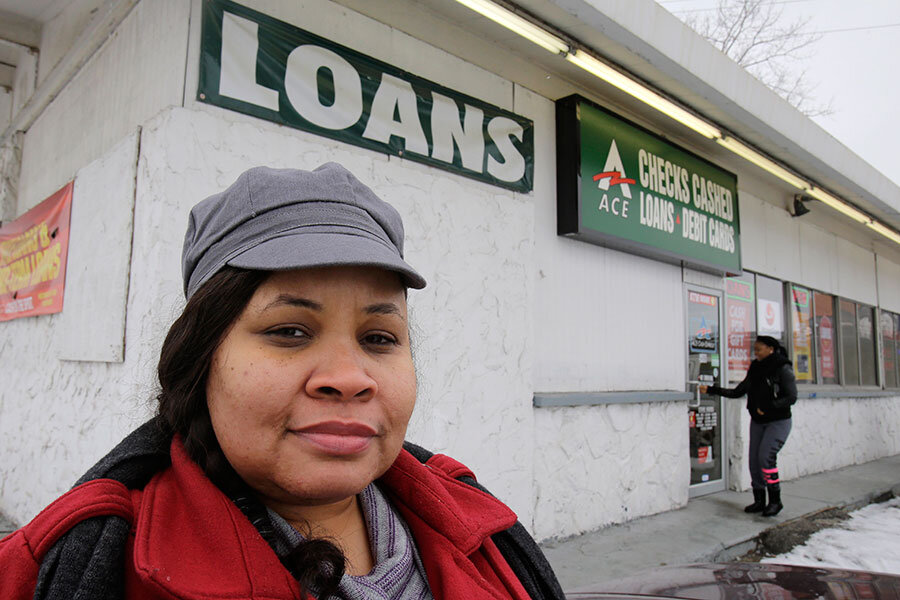'Pink-lining': how dubious debt products entrap poor women
Loading...
Wall Street is exploiting the gender pay gap by targeting working women with high-cost debt that increases their financial woes, according to a network of community activists.
Women of color are particularly vulnerable to predatory practices by subprime lenders, whether for home mortgages or short-term loans, according to the activists’ report issued Tuesday. They accuse the finance industry of “pink-lining,” a reference to the long-discredited practice by banks of “red-lining” black-majority neighborhoods.
In an election cycle where the plight of the white male working class has often been in the spotlight, the report is a reminder of the unequal burden that falls on working women. They make up the majority of workers in the low-wage service sector and are more likely to be part-timers, not necessarily by choice. Some 10 million women are single-parent heads of households; nearly half live below the official poverty line, according to census data.
Whereas red-lining was the denial of credit, the modern equivalent is the selling of dubious debt products that entrap poor women, says Suparna Bhaskaran, the report’s author. The result is the “transfer of assets and wealth from low-income women and women of color to the financial sector.”
Lorian Smith, a hospital worker from East Orange, N.J., is an example of the debt trap. On a conference call Tuesday for the report’s launch, she told reporters she lost two jobs during the financial crash and struggled to keep up payments on the subprime mortgage on her home, which she had bought in 2001. She eventually got a loan modification but says she still worries about foreclosure.
“I have played by all the rules,” she said. “I got an education. Got a career. Bought a home. Raised a family. But … debt has become a vicious circle in my life.”
Many of the claims made in the report are familiar, particularly on the subprime mortgages that fed the 2000s housing boom. Lenders were accused then of steering minority borrowers toward higher-cost loans even when their credit scores qualified them for cheaper deals. Auto financing has also been investigated by federal regulators: The Consumer Financial Protection Bureau (CFPB) fined Toyota and other companies for racial discrimination in the pricing of auto loans.
The newest priority, activists say, are payday loans. The CFPB recently proposed new regulations for the payday loan industry, which serves millions of customers with short-term debt that can become prohibitively costly. The proposed rules impose underwriting restrictions on lenders but doesn’t cap the rates they charge.
The CFPB should adopt the toughest possible rules on payday lending, says Amy Schur of ACCE Institute in California, one of the three community organizations behind the “pink-lining” report. She also called for the agency to investigate how women are profiled by the finance industry and go after any discriminatory practices.
That could prove a tough case to make. Low-income households with low or impaired credit represent a profitable market for banks and payday lenders. That women are more likely to be in these households and to borrow at high cost doesn’t mean that lenders are discriminating, unless they can be shown to have charged them more than equivalent male borrowers.
In 2005, at the height of the housing boom, 1 in 3 women received subprime mortgages compared with 1 in 4 men, according to the Center for Responsible Lending, a North Carolina-based advocacy group. Controlled for income and credit scores, women were at least 30 percent more likely than men to be sold such loans, the group found.
“People of color and women pay substantially more for the same loan with the same background and credit history, and we’ve got to stop this,” Rep. Keith Ellison (D) of Minnesota and a member of the House Financial Services Committee told reporters on the call.
Activists say they understand that lenders need to make a profit and that women need access to credit. They say their campaign to hold Wall Street to account goes hand in hand with a broader progressive agenda for workers, including a higher minimum wage and paid parental leave, that would provide a path for women and women of color to build wealth and escape the debt trap.
“What we’re asking for is not for people to be locked out of that marketplace but for the rules and regulations to be written so as to be responsible,” says Andrea Flynn, a researcher on women’s issues at the Roosevelt Institute, who joined the call.
Studies of payday lenders have found that they are more likely to open stores in majority African-American and Latino neighborhoods. Lenders have denied that minorities are targeted and say that locations are based on demand and convenience.
To test these claims, Jim Hawkins, a law professor at the University of Houston, compared the advertising of payday and auto-title lenders in Texas with their customer base. In a 2015 study he found that women and minorities were more likely to be featured by lenders on their websites. Broken down by race, whites make up 58 percent of lending customers in Texas, but were only present in 35 percent of the online advertising. For blacks, the situation was reversed.
“That’s who they’re targeting. You advertise to target certain people,” says Mr. Hawkins.
Women make up 52 percent of payday borrowers in Texas, while 63 percent of pictures on payday websites were of women. Still, Hawkins said the comparison was complicated by the fact that advertisers could be using women to market to men, as is the case for other consumer products.
The “pink-lining” report uses survey data gathered by ACCE, Isaiah, a faith-based group in Minnesota, and New Jersey Communities United, based in Newark. It features testimony from some of the 771 survey participants in and around Los Angeles, Minneapolis, and Newark. Many said their problems with debt – student loans, payday lending, and home mortgages – had negatively affected their physical and emotional health.








